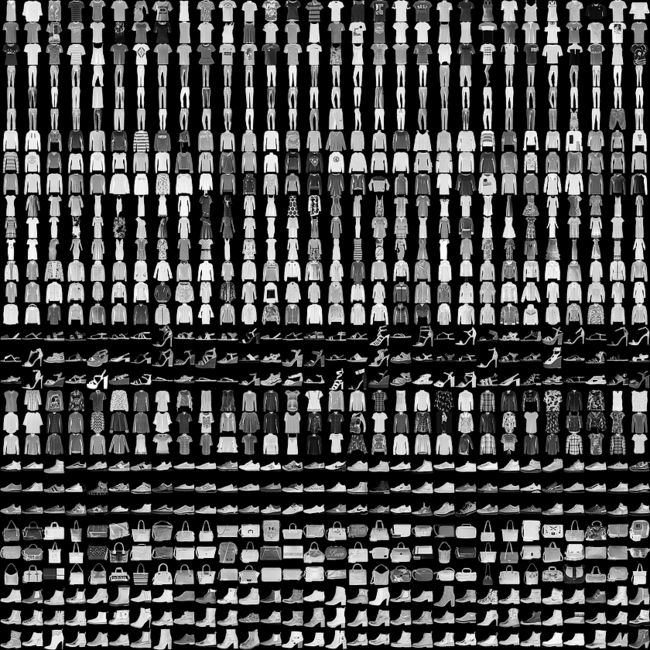开始使用tensorflow
原文地址
训练首个神经网络:基本分类
对于初学者,即使不了细节也没关系,本次教程只是简要介绍一个完整的Tensorflow程序,而且后续我们会详细介绍。
本次使用的是tf.eras,它是一种用于在Tensorflow中构建和训练模型的高阶API
#Tensorflow and tf.keras
import tensorflow as tf
from tensorflow import keras
#相关库
import numpy as np
import matplotlib.pyplot as plt
print(tf.__version__)
输出:
1.12.0-rc1
导入Fashion MNIST 数据集
本次指南使用 Fashion MNIST
其中包含 70000 张灰度图像,涵盖 10 个类别。我们将使用 60000 张图像训练网络,并使用 10000 张图像评估经过学习的网络分类图像的准确率。您可以从 TensorFlow 直接访问 Fashion MNIST,只需导入和加载数据即可:
fashion_mnist = keras.datasets.fashion_mnist
(train_images, train_labels), (test_images, test_labels) = fashion_mnist.load_data()
加载数据集会返回 4 个 NumPy 数组:
- train_images 和 train_labels 数组是训练集,即模型用于学习的数据。
- 测试集 test_images 和 test_labels 数组用于测试模型。
图像为 28x28 的 NumPy 数组,像素值介于 0 到 255 之间。标签是整数数组,介于 0 到 9 之间。这些标签对应于图像代表的服饰所属的类别:
每张图像都映射到一个标签。由于数据集中不包含类别名称,因此将它们存储在此处,以便稍后在绘制图像表时使用:
class_names = ['T-shirt/top', 'Trouser', 'Pullover', 'Dress', 'Coat','Sandal', 'Shirt', 'Sneaker', 'Bag', 'Ankle boot']
预处理数据
必须先对数据进行预处理,然后再训练网络。如果您检查训练集中的第一张图像,就会发现像素值介于 0 到 255 之间:
plt.figure()
plt.imshow(train_images[0])
plt.colorbar()
plt.grid(False)
我们将这些值缩小到 0 到 1 之间,然后将其馈送到神经网络模型。为此,将图像组件的数据类型从整数转换为浮点数,然后除以 255。以下是预处理图像的函数,
务必要以相同的方式对训练集和测试集进行预处理:
train_images = train_images / 255.0
test_images = test_images / 255.0
显示训练集中的前 25 张图像,并在每张图像下显示类别名称。验证确保数据格式正确无误,然后我们就可以开始构建和训练网络了。
plt.figure(figsize=(10,10))
for i in range(25):
plt.subplot(5,5,i+1)
plt.xticks([])
plt.yticks([])
plt.grid(False)
plt.imshow(train_images[i], cmap=plt.cm.binary)
plt.xlabel(class_names[train_labels[i]])
构建模型
构建神经网络需要先配置模型的层,然后再编译模型。
设置层
神经网络的基本构造块是层。层从馈送到其中的数据中提取表示结果。希望这些表示结果有助于解决手头问题。
大部分深度学习都会把简单的层连在一起。大部分层(例如 tf.keras.layers.Dense)都具有在训练期间要学习的参数。
model = keras.Sequential([
keras.layers.Flatten(input_shape=(28, 28)),
keras.layers.Dense(128, activation=tf.nn.relu),
keras.layers.Dense(10, activation=tf.nn.softmax)
])
该网络中的第一层 tf.keras.layers.Flatten 将图像格式从二维数组(28x28 像素)转换成一维数组(28 * 28 = 784 像素)。可以将该层视为图像中像素未堆叠的行,并排列这些行。该层没有要学习的参数;它只改动数据的格式。
在扁平化像素之后,该网络包含两个 tf.keras.layers.Dense 层的序列。这些层是密集连接或全连接神经层。第一个 Dense 层具有 128 个节点(或神经元)。第二个(也是最后一个)层是具有 10 个节点的 softmax 层,该层会返回一个具有 10 个概率得分的数组,这些得分的总和为 1。每个节点包含一个得分,表示当前图像属于 10 个类别中某一个的概率。
编译模型
模型还需要再进行几项设置才可以开始训练。这些设置会添加到模型的编译步骤:
损失函数 - 衡量模型在训练期间的准确率。我们希望尽可能缩小该函数,以“引导”模型朝着正确的方向优化。
优化器 - 根据模型看到的数据及其损失函数更新模型的方式。
指标 - 用于监控训练和测试步骤。以下示例使用准确率,即图像被正确分类的比例。
model.compile(optimizer=tf.train.AdamOptimizer(),
loss='sparse_categorical_crossentropy',
metrics=['accuracy'])
训练模型
训练神经网络模型需要执行以下步骤:
1.将训练数据馈送到模型中,在本示例中为 train_images 和 train_labels 数组。
2.模型学习将图像与标签相关联。
3.我们要求模型对测试集进行预测,在本示例中为 test_images 数组。我们会验证预测结果是否与 test_labels 数组中的标签一致。
要开始训练,请调用 model.fit 方法,使模型与训练数据“拟合”:
model.fit(train_images, train_labels, epochs=5)
Epoch 1/5
60000/60000 [==============================] - 5s 87us/step - loss: 0.5033 - acc: 0.8242
Epoch 2/5
60000/60000 [==============================] - 5s 80us/step - loss: 0.3803 - acc: 0.8643
Epoch 3/5
60000/60000 [==============================] - 5s 85us/step - loss: 0.3399 - acc: 0.8758
Epoch 4/5
60000/60000 [==============================] - 5s 87us/step - loss: 0.3141 - acc: 0.8855
Epoch 5/5
60000/60000 [==============================] - 5s 88us/step - loss: 0.2941 - acc: 0.8917
在模型训练期间,系统会显示损失和准确率指标。该模型在训练数据上的准确率达到 0.88(即 88%)。
评估准确率
test_loss, test_acc = model.evaluate(test_images, test_labels)
print('Test accuracy:', test_acc)
10000/10000 [==============================] - 1s 50us/step
Test accuracy: 0.8734
结果表明,模型在测试数据集上的准确率略低于在训练数据集上的准确率。训练准确率和测试准确率之间的这种差异表示出现过拟合。如果机器学习模型在新数据上的表现不如在训练数据上的表现,就表示出现过拟合。
做出预测
模型经过训练后,我们可以使用它对一些图像进行预测。
predictions = model.predict(test_images)
在本示例中,模型已经预测了测试集中每张图像的标签。我们来看看第一个预测:
predictions[0]
array([4.2577299e-06, 7.2840301e-08, 2.3979945e-08, 2.0671453e-06,
9.1094840e-08, 1.2096325e-01, 1.5182156e-06, 1.9717012e-01,
1.2066002e-05, 6.8184656e-01], dtype=float32)
预测结果是一个具有 10 个数字的数组。这些数字说明模型对于图像对应于 10 种不同服饰中每一个服饰的“置信度”。我们可以看到哪个标签的置信度值最大:
np.argmax(predictions[0])
9
因此,模型非常确信这张图像是踝靴或属于 class_names[9]。我们可以检查测试标签以查看该预测是否正确:
test_labels[0]
9
我们可以将该预测绘制成图来查看全部 10 个通道
def plot_image(i, predictions_array, true_label, img):
predictions_array, true_label, img = predictions_array[i], true_label[i], img[i]
plt.grid(False)
plt.xticks([])
plt.yticks([])
plt.imshow(img, cmap=plt.cm.binary)
predicted_label = np.argmax(predictions_array)
if predicted_label == true_label:
color = 'blue'
else:
color = 'red'
plt.xlabel("{} {:2.0f}% ({})".format(class_names[predicted_label],
100*np.max(predictions_array),
class_names[true_label]),
color=color)
def plot_value_array(i, predictions_array, true_label):
predictions_array, true_label = predictions_array[i], true_label[i]
plt.grid(False)
plt.xticks([])
plt.yticks([])
thisplot = plt.bar(range(10), predictions_array, color="#777777")
plt.ylim([0, 1])
predicted_label = np.argmax(predictions_array)
thisplot[predicted_label].set_color('red')
thisplot[true_label].set_color('blue')
我们来看看第 0 张图像、预测和预测数组。
i = 0
plt.figure(figsize=(6,3))
plt.subplot(1,2,1)
plot_image(i, predictions, test_labels, test_images)
plt.subplot(1,2,2)
plot_value_array(i, predictions, test_labels)
i = 12
plt.figure(figsize=(6,3))
plt.subplot(1,2,1)
plot_image(i, predictions, test_labels, test_images)
plt.subplot(1,2,2)
plot_value_array(i, predictions, test_labels)
我们用它们的预测绘制几张图像。正确的预测标签为蓝色,错误的预测标签为红色。数字表示预测标签的百分比(总计为 100)。请注意,即使置信度非常高,也有可能预测错误。
# Plot the first X test images, their predicted label, and the true label
# Color correct predictions in blue, incorrect predictions in red
num_rows = 5
num_cols = 3
num_images = num_rows*num_cols
plt.figure(figsize=(2*2*num_cols, 2*num_rows))
for i in range(num_images):
plt.subplot(num_rows, 2*num_cols, 2*i+1)
plot_image(i, predictions, test_labels, test_images)
plt.subplot(num_rows, 2*num_cols, 2*i+2)
plot_value_array(i, predictions, test_labels)
最后,使用经过训练的模型对单个图像进行预测。
# Grab an image from the test dataset
img = test_images[0]
print(img.shape)
(28,28)
tf.keras 模型已经过优化,可以一次性对样本批次或样本集进行预测。因此,即使我们使用单个图像,仍需要将其添加到列表中:
# Add the image to a batch where it's the only member.
img = (np.expand_dims(img,0))
print(img.shape)
(1, 28, 28)
现在,预测这张图像:
predictions_single = model.predict(img)
print(predictions_single)
[[4.25773487e-06 7.28401730e-08 2.39799487e-08 2.06714572e-06
9.10946838e-08 1.20963275e-01 1.51821587e-06 1.97170004e-01
1.20659797e-05 6.81846678e-01]]
plot_value_array(0, predictions_single, test_labels)
_ = plt.xticks(range(10), class_names, rotation=45)
model.predict 返回一组列表,每个列表对应批次数据中的每张图像。(仅)获取批次数据中相应图像的预测结果:
np.argmax(predictions_single[0])
9
和刚才一样,模型预测的标签为 9。







